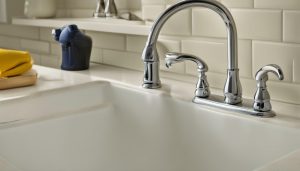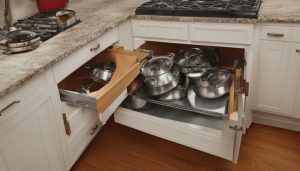Dealing with a clogged kitchen sink is a common household problem that can be frustrating. If your sink is filled with standing water, it’s essential to act fast to unclog it. In this section, we will provide you with a step-by-step guide on how to unclog a kitchen sink filled with standing water. Our guide covers effective methods and techniques to get your sink back to its smoothly running condition.
Key Takeaways
- Understanding the cause of the clog is important for effective unclogging.
- Assess the severity of the clog before proceeding with any unclogging method.
- Simple DIY solutions can be effective in removing mild to moderate clogs.
- Chemical drain cleaners can be used for stubborn clogs, but caution is required when using them.
- A plunger is a highly effective tool for unclogging a kitchen sink.
- Snaking the kitchen sink drain can be used for deep clogs.
- Prevent future clogs by practicing proper waste disposal and regular maintenance.
- If DIY solutions fail to unclog the sink, calling a plumber may be necessary.
Understanding the Problem: Kitchen Sink Clogged and Filled with Standing Water
A clogged kitchen sink drain can be a common household problem, especially if you’re in the habit of disposing of food scraps and grease down the drain. Over time, these can build up, block the drain, and eventually lead to standing water.
The usual suspect, in this case, is a build-up of organic matter, such as food scraps, grease, and fat, which accumulates in the drainpipe and traps other debris, including soap, hair, and dirt. This build-up restricts water flow and causes it to back up into the sink, leaving you with a clogged drain and standing water.
Other factors that can contribute to a clogged kitchen sink drain include the use of inappropriate materials, such as flushable wipes, coffee grounds, and eggshells, as well as structural issues, such as old and corroded pipes.
If left unaddressed, clogged drains can cause further damage, such as the development of foul odors, mold growth, and even pipe corrosion. Therefore, it’s essential to understand the problem and take necessary measures to unclog the kitchen sink.
Assessing the Severity of the Clog
Before attempting to unclog a kitchen sink, it’s important to determine the severity of the clog. This will help you choose the right unclogging method and avoid causing any damage to your sink. Here are some methods to assess the clogging level:
- Run hot water in the sink for a few minutes. If the water drains slowly or not at all, the clog is likely at the surface level and can be easily fixed with DIY solutions.
- If the sink is still filled with standing water, use a plunger to dislodge the clog. If the water level drops, the clog is near the surface level. If the water level stays the same, the clog is deeper in the drain.
- You can use a flashlight to inspect the drain. If you can see any visible obstruction, such as food scraps or grease buildup, the clog is likely near the surface level.
- If the clog is deeper in the drain, you can try snaking the drain or using chemical drain cleaners. Be cautious when using chemical drain cleaners as they can be harsh and damaging to your pipes if not used correctly.
Choosing the right clog remover is crucial for unclogging your kitchen sink effectively. There are various types of kitchen sink clog removers available, including enzymatic drain cleaners, acid-based cleaners, and hydro-mechanical cleaners. Enzymatic drain cleaners are eco-friendly and safe, while acid-based cleaners can be harmful and corrosive to your pipes. Hydro-mechanical cleaners use water pressure to dislodge the clog.
Now that you know how to assess the severity of the clog and choose the right clog remover, you can proceed with unclogging your kitchen sink. In the next sections, we will provide you with step-by-step guides on DIY solutions, using chemical drain cleaners, plunging, snaking, and maintenance tips to keep your sink clog-free.
Simple DIY Solutions for Unclogging a Kitchen Sink
If you’re dealing with a moderately clogged sink, there are several simple and effective DIY solutions to unclog it. These kitchen sink drainage solutions utilize common household items and are easy to implement.
Baking Soda and Vinegar Solution
This is a tried and tested method that involves using the powerful combination of baking soda and vinegar to clear a clogged kitchen sink. Here’s how to do it:
- Pour one cup of baking soda down the sink drain.
- Follow it up with one cup of white vinegar.
- Cover the drain with a stopper or a wet cloth to prevent the solution from escaping.
- After a few minutes, flush the drain with hot water.
Repeat this process a few times if necessary until the clog is cleared.
Boiling Water
If the clog is mild, boiling water can do the trick. This method is straightforward and quick to implement. Here’s how to do it:
- Boil a large pot of water on the stove.
- Pour the hot water down the drain in three to four stages, allowing each pour to work through the clog.
- Be careful when pouring the water to avoid burns.
If the clog is not too severe, this method should clear it. However, avoid using boiling water if you have PVC pipes, as it can cause them to loosen and burst.
Baking Soda and Salt Solution
Another simple solution to unclog a kitchen sink is by using baking soda and salt. This method is especially effective for grease buildup. Here’s how to do it:
- Mix half a cup of baking soda and half a cup of salt.
- Pour the mixture down the drain.
- Let it sit for a few hours or overnight.
- Flush the drain with hot water.
For best results, use this method regularly to prevent future clogs.
These tips to unclog a kitchen sink are effective for mild to moderate clogs. However, if the clog is severe or persists, it’s best to seek professional help or try other methods.
Using Chemical Drain Cleaners for Stubborn Clogs
If your kitchen sink clog is persistent and DIY solutions haven’t worked, you may need to turn to chemical drain cleaners. While these products can be effective, they can also be dangerous and should be handled with care. Follow these steps to safely use chemical drain cleaners:
- Choose the right product: There are different types of chemical drain cleaners available, including acid-based and alkaline-based. Make sure you select a product that is suitable for your specific clog and follow the instructions carefully.
- Protect yourself: Wear rubber gloves and eye protection to avoid contact with the chemicals, which can be harmful to your skin and eyes.
- Prepare the area: Remove any standing water from the sink and surrounding area, and open windows or turn on a fan for ventilation.
- Apply the cleaner: Pour the recommended amount of cleaner into the drain and wait for the recommended time as per the instructions. Avoid splashes and do not mix different types of cleaners.
- Rinse thoroughly: After the recommended time, flush the drain with hot water for several minutes to remove the chemical cleaner and any debris.
Remember that chemical drain cleaners should only be used as a last resort, as they can damage your pipes if overused or used improperly. If you are uncomfortable using chemicals, consider calling a plumber to deal with the stubborn kitchen sink clog.
Clearing Clogs with a Plunger
Using a plunger is a simple yet effective way to unclog a kitchen sink. To start with, you need to select the right plunger, a cup plunger, which has a flat bottom and a dome-shaped rubber cup that creates suction. Make sure the plunger is clean and has no tears or cracks on the rubber cup.
Next, run hot water in the sink and hold the plunger upright, covering the drain with the rubber cup. Press down gently to create a seal, and then start pumping the plunger up and down quickly. You can apply some force, but be careful not to break the seal or damage the pipes.
Pump the plunger for 20 to 30 seconds and then lift it off the drain. Check if the water drains properly. If not, repeat the process a few times until you see improvement. Don’t forget to run hot water for a few minutes to flush out any remaining debris.
While plungers are generally safe to use, make sure you avoid using chemical drain cleaners before or after plunging. This can create a dangerous chemical reaction that can harm you or damage your pipes.
If you feel resistance or cannot clear the clog after multiple attempts, do not exert more force with the plunger. Instead, consider using a plumbing snake or seek professional help.
Snaking the Kitchen Sink Drain
If the clog in your kitchen sink is deep in the drain and stubborn, snaking the drain may be your best option. Snaking involves using a long, flexible wire to reach and dislodge the clog. It is a more advanced method compared to some DIY solutions, but it can be highly effective.
To snake your kitchen sink drain, follow these steps:
- Insert the snake into the drain until you feel resistance. This resistance is the clog.
- Gently turn the snake clockwise to break up the clog. Avoid using excessive force to prevent damaging the pipes.
- Continue snaking the drain until you no longer encounter resistance or until the entire length of the snake has been used up.
- Remove the snake from the drain and test the sink by running hot water. If the drain is still clogged, repeat the process or try another unclogging method.
Note: Snaking can sometimes push the clog further down the pipe, leading to a more complicated issue. If your snaking efforts do not result in a clear drain, it’s best to contact a professional plumber for assistance.
Prevention and Maintenance Tips for a Clog-Free Kitchen Sink
Kitchen sinks are prone to clogs due to frequent use and improper disposal of waste. Here are some preventive measures that can help you avoid a clogged kitchen sink:
- Use a drain strainer: Place a drain strainer over the sink drain to catch food particles and other debris. Empty the strainer regularly to avoid buildup.
- Avoid pouring grease: Grease is a major culprit in clogging kitchen sinks. Dispose of grease in a separate container and throw it in the trash once it solidifies.
- Scrape plates before washing: Scraping leftover food particles into the trash or compost bin can reduce the amount of food waste that goes down the sink drain.
- Run hot water: After using the sink, run hot water for a few seconds to help break down any residual oil or grease.
- Use vinegar and baking soda: Every few weeks, pour a cup of baking soda down the drain followed by a cup of vinegar. Cover the drain with a stopper and wait for at least 30 minutes before flushing the drain with hot water. This simple remedy can keep your kitchen sink clean and odor-free.
Regular maintenance can also prevent a clogged kitchen sink. Here are some practices to keep your sink drain running smoothly:
- Clean the sink: Use a mild cleaning solution and a soft sponge to clean the sink regularly.
- Check for leaks: Inspect the sink drain and pipes for leaks. Repair any leaks promptly to avoid water damage and mold growth.
- Have the drain professionally cleaned: Schedule a professional drain cleaning service every year to remove buildup and prevent clogs.
By following these simple preventive measures and regular maintenance, you can reduce the risk of a kitchen sink clogged with standing water.
Professional Help: When to Call a Plumber
If you have tried all the DIY methods and still cannot unclog your kitchen sink, it is time to call a professional plumber. Attempting to unclog the sink yourself can cause further damage to the plumbing system and end up costing more than hiring a professional in the first place.
If you are not comfortable with DIY solutions, it is better to call a plumber instead of risking personal injury or property damage. Plumbers have the necessary tools and expertise to handle any clogging issue, whether it is a simple blockage or a complicated one.
Additionally, if you notice that the clog is causing other issues such as water backing up or foul odor, it is better to call a plumber. These issues are an indication that the clog has become severe and requires immediate attention.
When choosing a plumber, ensure that they are licensed and insured. A licensed plumber has undergone the necessary training and has the experience to handle different types of plumbing issues. Also, ensure that they have a good reputation and provide a warranty for their services.
Overall, calling a professional plumber is the best course of action if DIY methods do not work, or you are not comfortable with them. It will save you time, money, and ensure that the clogging issue is resolved efficiently and effectively.
Conclusion
A kitchen sink clogged and filled with standing water can be a messy and frustrating problem. However, with the right techniques and methods, you can easily unclog your kitchen sink and keep it running smoothly. By following our step-by-step guide, you can avoid costly repairs and keep your sink in top condition.
Remember to assess the severity of the clog
Before starting any unclogging method, it’s important to assess the severity of the clog. This will help you determine the appropriate method to use. Using the wrong technique can cause further damage to your sink and pipes.
Prevention is key to a clog-free kitchen sink
To avoid future clogs, it’s important to practice good habits such as properly disposing of food waste and avoiding pouring grease down the drain. Additionally, regular maintenance such as cleaning the drain and using a natural drain cleaner can help keep your sink running smoothly.
When to seek professional help
If all your efforts fail to unclog the kitchen sink or if you don’t feel comfortable with DIY solutions, it’s best to seek professional help. A licensed plumber has the necessary tools and expertise to diagnose and fix the problem without causing further damage.
By using the right techniques, understanding the problem, and implementing prevention and maintenance tips, you can enjoy a clog-free kitchen sink for years to come.
FAQ
Q: How do I unclog a kitchen sink filled with standing water?
A: To unclog a kitchen sink filled with standing water, you can try several methods. First, remove any visible debris or food particles from the sink. Then, try using a plunger to dislodge the clog by creating suction. If that doesn’t work, you can try using a plumbing snake or chemical drain cleaners. It’s important to follow the instructions carefully and take necessary safety precautions when using chemicals.
Q: What are the common causes of a clogged kitchen sink?
A: There are several common causes of a clogged kitchen sink. Some of them include food debris, grease buildup, soap scum, and foreign objects. These can accumulate in the sink drain and trap other debris, leading to a clog. It’s important to be mindful of what goes down the sink and take preventive measures to avoid clogs.
Q: How do I assess the severity of a clog in my kitchen sink?
A: To assess the severity of a clog in your kitchen sink, you can start by checking the water flow. If the water drains slowly or is completely blocked, the clog may be severe. You can also try running water in other sinks or drains connected to the same plumbing line to see if they are affected. If the clog persists despite your attempts to unclog it, it may be best to seek professional help.
Q: What are some simple DIY solutions for unclogging a kitchen sink?
A: There are several simple DIY solutions you can try to unclog a kitchen sink. One method is to mix baking soda and vinegar and pour it down the drain, followed by hot water. Another option is to use a combination of salt and boiling water. You can also try using a plunger or a plumbing snake to dislodge the clog. Remember to follow the instructions carefully and take necessary safety precautions.
Q: Can I use chemical drain cleaners to unclog my kitchen sink?
A: Chemical drain cleaners can be used for stubborn clogs in a kitchen sink. However, it’s important to use them carefully and follow the instructions provided by the manufacturer. Choose a drain cleaner that is suitable for your specific clog and take necessary safety precautions, such as wearing protective gloves and eyewear. It’s also important to avoid mixing different drain cleaners, as this can create toxic fumes.
Q: How do I use a plunger to clear a clog in my kitchen sink?
A: Using a plunger can be an effective way to clear a clog in your kitchen sink. Start by removing any standing water from the sink. Place the plunger over the drain and create a tight seal. Push down firmly and then pull up quickly to create suction. Repeat this motion several times until the clog is dislodged. Run water to check if the clog is cleared, and repeat the process if needed.
Q: How do I snake the kitchen sink drain to clear a clog?
A: If the clog in your kitchen sink is deep in the drain, you can use a plumbing snake to clear it. Start by inserting the snake into the drain until you feel resistance. Rotate the snake clockwise and push it forward, keeping a firm grip. Continue feeding the snake until you reach the clog. Once you reach the clog, move the snake back and forth to break it up. Retrieve the snake and run water to check if the clog is cleared.
Q: What are some prevention and maintenance tips for a clog-free kitchen sink?
A: To prevent clogs in your kitchen sink, avoid putting large food particles, grease, and oil down the drain. Use a sink strainer to catch debris and regularly clean it. Run hot water down the drain after each use to help flush out any buildup. Additionally, consider using enzyme-based drain cleaners periodically to keep the drain clear. Regular maintenance and proper disposal of waste can help keep your kitchen sink clog-free.
Q: When should I call a plumber to unclog my kitchen sink?
A: If your attempts to unclog the kitchen sink with DIY methods have been unsuccessful or if you are not comfortable with trying them, it’s best to call a plumber. Additionally, if you suspect the clog is deep in the plumbing system or if you experience recurrent clogs despite your preventive efforts, professional help may be necessary. A plumber will have the expertise and equipment to effectively diagnose and resolve the issue.

It’s me, Amber Hayden, the heart and soul behind SagarmathaOnlineMedia.com. From a young age, I’ve been head over heels for everything home-related, from interior decor to gardening. I’m the type who can’t resist a well-crafted piece of furniture, and I firmly believe that a home isn’t complete without a pet or two. But it’s not just about creating pretty spaces for me. I’m all about making homes that tell a story reflecting the people living there. SagarmathaOnlineMedia.com is my way of sharing this passion with you. Whether you’re looking for tips to jazz up your living room, advice on pet care, or ideas to make your garden bloom, I’m here to help. So, let’s embark on this journey together and make your house a home!



